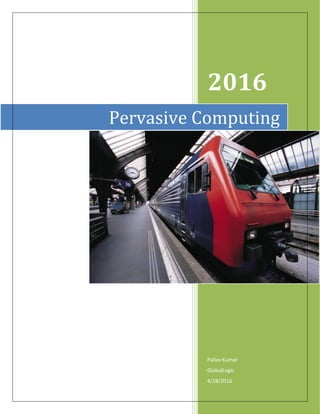
Pervasive computing
- 2. Pervasive computing revolutionizes the way individual interaction, communicate, and collaborate in an elegant fashion with the world around them. A concept based on the vision described by Mark Weiser nearly a decade ago: “The most profound technologies are those that disappear. They weave themselves into the fabric of everyday life until they are indistinguishable from it” Computing is no longer a discrete activity bound to a desktop; network computing and mobile computing are fast becoming a part of everyday life and so is the Internet. Rather than being an infrastructure for computers and their users alone, it is now an infrastructure for everyone. We expect devices like PDAs (Personal Digital Assistants), mobile phones, offices PCs and even home entertainment systems to access information and work together in one integrated system and the challenge is to combine these technologies into a seamless whole and on the Internet.
- 3. Definition Pervasive Computing is a computing technology that pervades the users’ environment by making use of seamless connectivity of multiple independent information devices embedded in the environment of the users. It does so by: Making use of multiple independent information devices (fixed or mobile, homogeneous or heterogeneous) Interconnecting these devices seamlessly through wireless or wired computer communication networks Providing a class of computing / sensory / communication services to a class of users, preferably transparently and can provide personalized services while ensuring a fair degree of privacy / non-intrusiveness.
- 4. Enterprise vision Pervasive computing is an integral component of building tomorrow’s enterprises. By turning nearly everything into a computing device, pervasive computing is making it imperative for companies to reach their end-users through a multitude of devices — both wired and wireless. Users in turn are accessing content and applications through multiple channels as well as social networks, resulting in an exponential growth of data that needs to be constantly monitored and analyzed. Intelligent enterprises are drawing inferences as well as key decision points by analyzing data from various sources about their customers, competitors, vendors, markets, products as well as services. Enterprises are able to garner localized, specific intelligence using sensor networks, thereby enabling them to develop innovative products and services, which are better aligned to market needs. Just in time computing and storage, using cloud based computing platforms and services are resulting in commoditization of infrastructure thereby enabling enterprises to better optimize computing and storage power. Infosys is leveraging these technologies to deliver lower Total Cost of Ownership (TCO), higher quality of service and better agility for our client Enterprises need to provide a seamless user experience across multiple access devices as well as multiple access networks. They need to effectively connect and engage end customers through different networks. Analysis of the vast amount of data collected through these networks allows organizations to study demographics of their users and cater to them accordingly.
- 5. Advantages We increasingly rely on the electronic creation, storage, and transmittal of personal, financial, and other confidential information, and demand the highest security for all these transactions and require complete access to time-sensitive data, regardless of physical location. We expect devices -- personal digital assistants, mobile phones, office PCs and home entertainment systems -- to access that information and work together in one seamless, integrated system. Pervasive computing gives us the tools to manage information quickly, efficiently, and effortlessly. It aims to enable people to accomplish an increasing number of personal and professional transactions using a new class of intelligent and portable appliances or "smart devices" embedded with microprocessors that allow users to plug into intelligent networks and gain direct, simple, and secure access to both relevant information and services. It gives people convenient access to relevant information stored on powerful networks, allowing them to easily take action anywhere, anytime. Pervasive computing simplifies life by combining open standards-based applications with everyday activities. It removes the complexity of new technologies, enables us to be more efficient in our work and leaves us more leisure time and thus pervasive computing is fast becoming a part of everyday life.
- 6. From Developer’s Prospective Mobile and stationary devices will dynamically connect and coordinate to seamlessly help people in accomplishing their tasks. However, for this vision to become a reality, developers must build applications that constantly adapt to a highly dynamic computing environment. թ Systems need to expose change, so that applications can implement their own strategies for handling changes. թ Systems need to make it easy to compose applications and services dynamically, so that they can be extended at runtime. թ Systems need to separate data and functionality, so that they can be managed separately and evolve independently. Systems need to be dynamically reconfigured in order to properly adapt to their environment (context). An appropriate solution to provide re-configurability is Aspect- Oriented Software Development. Business objects are exposed as services considering all security facets.
- 7. Evolution
- 8. Winding up… Pervasive computing provides an attractive vision for the future of computing. Well, we no longer will be sitting down in front of a PC to get access to information. In this wireless world we will have instant access to the information and services that we will want to access with devices, such as Smartphone’s, PDAs, set-top boxes, embedded intelligence in your automobile and others, all linked to the network, allowing us to connect anytime, anywhere seamlessly, and very importantly, transparently. Computational power will be available everywhere through mobile and stationary devices that will dynamically connect and coordinate to smoothly help users in accomplishing their tasks.
